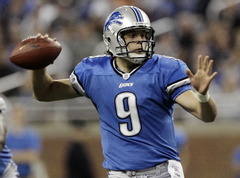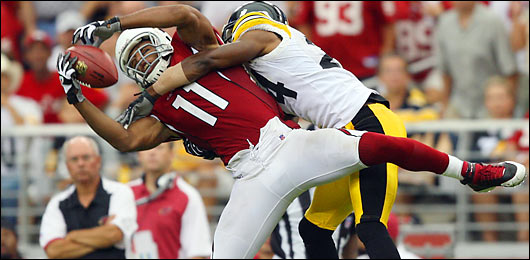Fitz on Fantasy: Thirteen Overvalued Players for 2013
Hello, dear reader. This is the first of what I hope to be many articles for The Football Girl. Before I heap scorn upon some NFL players, please allow me to introduce myself.
Since 2000, I’ve been contributing fantasy football articles and player rankings to Pro Football Weekly, and I was a full-time editor there for a few years in the late ’90s. PFW shut down in June after years of financial struggles. It was a wonderful organization full of terrific people, and I’m really going to miss it. I’ll be forever indebted to owner/publisher Hub Arkush for giving me the opportunity to contribute.
Now I’m indebted to Melissa Jacobs for giving me the opportunity to contribute to The Football Girl. TFG was one of the many joyous discoveries I’ve made since finally getting on Twitter a year ago. I’ve become a big fan of the site and am proud to have my work appear here.
I’m still a full-time editor, though I’ll spare you the boring details. I live in the northwest suburbs of Chicago with my beautiful wife of nine years and our two awesome kids, a 7-year-old daughter and a 6-year-old son. Having grown up in Whitefish Bay, Wis., a suburb of Milwaukee, I’m a devoted fan of the Green Bay Packers. I bleed melted cheddar. And having graduated from the University of Wisconsin-Madison, I also live and die with the Wisconsin Badgers. I love golf, wine, pizza and The Replacements. I hate green peppers, coconut, the Chicago Cubs and the Dave Matthews Band. I’ve been playing fantasy football since 1991.
But enough about me. Let’s talk about Matthew Stafford…
[Ed. Note: Not only has Pat been playing fantasy since the days of beta and Kid n’ Play, he happens to have a knack for it. In fact, in an evaluation of over 100 fantasy experts’ rankings last season, Pat ranked no. 3 in accuracy. We are thrilled to have him join the TFG team.]
Half of the aging jocks and liquored-up college kids trying to break plates to win giant stuffed animals at the local fair this weekend will display better throwing mechanics than Matthew Stafford. As a devoted Packer fan who watched every throw Brett Favre ever made during his years in Green Bay, I realize that an NFL quarterback doesn’t have to display picture-perfect form on every throw to get the job done. But if Favre dropped into a sidearm throwing motion, it was typically because he had a defender charging toward him with arms raised. There were times last season when Stafford threw sidearm without any defenders in his immediate vicinity. He also seems to enjoy throwing off his back foot, a mechanical no-no.
But the reasons why Stafford won’t be on any of my fantasy teams this year go beyond just sloppy mechanics.
Stafford set an NFL record for passing attempts last season with 727. The next most prolific chucker, Drew Brees, attempted 57 fewer passes than Stafford but threw for 210 more yards. Stafford also led the league in passing attempts two seasons ago, when he attempted 663 passes — the fifth-highest total in NFL history. So over the past two years, Stafford has been responsible for two of the five highest passing-attempt totals in league history.
The Stafford advocates note that he threw for an uncharacteristically low number of touchdowns last season (20) and that his TD count is likely to rise. I agree. But the Staff-ophiles also seem to believe that he’ll once again attempt an obscene number of passes. I’m not willing to make that assumption.
Almost every NFL head coach aspires to some semblance of balance between run and pass, the motivation being that an offense is harder to defend if a defense is uncertain about what’s coming. Perhaps Lions head coach Jim Schwartz is the rare coach who, like the Saints’ Sean Payton or the Packers’ Mike McCarthy, isn’t particularly interested in a balanced offense. Recent history would suggest that’s the case. But recent history would also suggest that the Lions might be better off trying a different plan.
It’s not as if Detroit lacks competent running backs. Newcomer Reggie Bush and holdovers Mikel Leshoure and Joique Bell are capable of giving the Lions a respectable ground game (though admittedly, Bush and Bell might be better pass catchers than runners).
If the Lions aren’t as pass-happy this year, Stafford’s yardage numbers could plummet. Aaron Rodgers ranked 10th in the league in passing attempts (while playing in a pass-heavy offense) and still threw 175 fewer passes than Stafford last season. If Stafford throws 175 fewer passes this year and duplicates last year’s average of 6.8 yards per attempt, he’ll finish with 1,190 fewer passing yards — about 74 fewer yards per game. That would be quite a haircut.

A bolstered running attack could hamper Stafford’s numbers.
FantasyPros.com (a marvelous tool for fantasy owners, by the way) recently listed Stafford’s average draft position (ADP) at QB9, and he’ll go earlier than that in a lot of leagues. At that price, no me gusta.
Davis Mattek of Rotoviz, a young wunderkind among the ever-growing legion of fantasy football analysts, recently wrote this:
“In fantasy football, the idea is not to be right 100% of the time, but rather to make a series of bets that improve our odds of winning.”
Mattek’s assessment is spot-on. The corollary to that involves the bets that fantasy owners don’t make. If a player fails to inspire our confidence, we decline to place a wager on him and instead let another owner invest.
Some of the players discussed here will have good seasons in 2013. But these are players I’m uncomfortable wagering upon, and ADP information suggests that other owners will be happy to place wagers while I keep my chips pocketed.
Carson Palmer (QB20) — The 33-year-old Palmer is an upgrade over the sordid cast of linguine-armed flutterballers the Cardinals trotted out at quarterback last season, but he’s no Kurt Warner either. A downfield passer who’s as immobile as Palmer needs a good offensive line in front of him, and the Cardinals don’t have one. There will be better backup fantasy quarterbacks available.
Steven Jackson (RB11) — Optimism for Jackson is near-universal. Finally freed from St. Louis, this noble old war horse now joins one of the most explosive offenses in the league, one so prolific that it helped plodding has-been Michael Turner stumble his way into the end zone 10 times last season. That’s the popular narrative, anyway. But Jackson turns 30 next week and is past the point at which running backs typically start to decline. Perhaps the less obvious concern is that Atlanta’s offensive line is in a state of erosion. Yes, Jackson has spent years running behind terrible offensive lines. But if he’s going from one team with a bad offensive line to another, should we really be so pleased with his new situation? Personally, I’d rather take my chances with a different senior-citizen running back, San Francisco’s Frank Gore, who runs behind the NFL’s best offensive line but has an ADP five spots lower than Jackson’s.
Maurice Jones-Drew (RB15) — With 76 career touchdowns over seven NFL seasons, MJD has built a lot of goodwill with fantasy owners, which might explain why he’s being drafted so early despite being a high-mileage running back coming off foot surgery. His supporting cast is lousy, too, and while that hasn’t hindered him in the past, the 28-year-old MJD may have reached the age at which he needs a little help from his friends.
Rashard Mendenhall (RB29) — At first glance, this might not seem like an unreasonable ADP for a player likely to open the season as his team’s No. 1 running back. But this ADP is no bargain. Lacking explosion and wiggle, Mendy is the sort of runner who needs a good offensive line in front of him, and he isn’t going to have one. The Cardinals also have a cadre of young running backs (Ryan Williams, Stepfan Taylor, Andre Ellington) who could get looks if (when) the Cardinals’ season starts to collapse.
Dez Bryant (WR3) — Bryant produced such scintillating numbers over the final eight games of last season (50 catches, 879 yards, 10 TDs) that most fantasy owners seem willing to overlook his numerous past instances of knuckleheadedness. Dez says he’s found himself, and maybe he has, but I tend to be cynical about such things. If I’m going to invest in a top receiver not named Calvin Johnson, I’d simply feel safer with A.J. Green, Brandon Marshall, Demaryius Thomas or Julio Jones. Cowboys WR Miles Austin was dealing with a hamstring injury late last season, and that malady no doubt had something to do with Bryant’s enormous workload over the second half of the season. If Austin stays healthy this year, he could sink his teeth into Bryant’s totals.
Larry Fitzgerald (WR7) — It almost seems as if the fantasy community is trying to will this guy to a good season. I get it. He’s been a phenomenal performer in the past. He’s likeable. My wife thinks he’s cute. He’s been saddled with lousy quarterbacks for years and is yearning to partner with one who can hit him between the jersey numbers with a tight spiral. But WR7 is too high for a player who’s turned in mediocre numbers in two of the last three seasons and whose pass-catching environment may have only marginally improved. Yes, the arrival of Carson Palmer should help. But if the Cardinals’ offensive-line woes are going to be a problem for Palmer (and they will be), they’re going to be a problem for Fitz, too.

Lack of faith in Palmer could lead to another disappointing season for Fitzgerald.
Percy Harvin (WR11) — During his four-year run with the Vikings, Harvin was a high-volume target who piled up receptions. Now he’s with the Seahawks, one of the most run-oriented teams in the league. Take away kick returns and Harvin has averaged only six TDs a season over his career. He also tends to get banged up a lot and may have diva tendencies. In general, drafting slot receivers early is a bad idea for fantasy owners, and Harvin doesn’t warrant an exception. He certainly has value in PPR leagues, but his current ADP (which is even higher in PPR leagues) may be overstating that value.
Eric Decker (WR22) — This doesn’t appear to be an unreasonable ADP for a guy who had 1,064 receiving yards and 13 TDs last season. But we know that Wes Welker’s arrival is going to alter the pass distribution in Denver, and Decker’s catch and target totals are in greater jeopardy than those of bona fide superstar Demaryius Thomas.
Greg Jennings (WR26) — Let’s just say that the drop-off from Aaron Rodgers to Christian Ponder is precipitous. Some of that is baked into Jennings’ current ADP, but this cake isn’t ready to come out of the oven at a temperature of WR26. Jennings’ transfer from Green Bay to Minnesota bodes ill for his fantasy prospects.
Cordarrelle Patterson (WR57) — This ADP suggests that the rookie is marginally draftable in most fantasy leagues, but he’d be a wasted pick. Although the Vikings traded up to draft him in the first round, Patterson is a major project. He has noteworthy speed and athleticism but comes with very little college passing-game experience. Expect sporadic big plays with yawning gaps of non-productivity in between.
Kyle Rudolph (TE7) — Hey, look: three Vikings in a row! Do I win our game of Norse Tic-Tac-Toe? Rudolph isn’t terrible, but his ADP is being driven by the nine touchdowns he scored last year. His 2012 average of 9.3 yards per catch speaks to his limitations. And have I mentioned that I don’t think highly of Vikings QB Christian Ponder?
Jared Cook (TE10) — Fantasy owners have long been intrigued by Cook’s combination of size and athleticism, but the former Tennessee Titan has mostly just teased us during his four NFL seasons. There’s hope that a change of venue will help unlock his potential. I’d be more optimistic if Cook had left Tennessee for, say, New England. A move to St. Louis probably isn’t going to awaken dormant magic.



